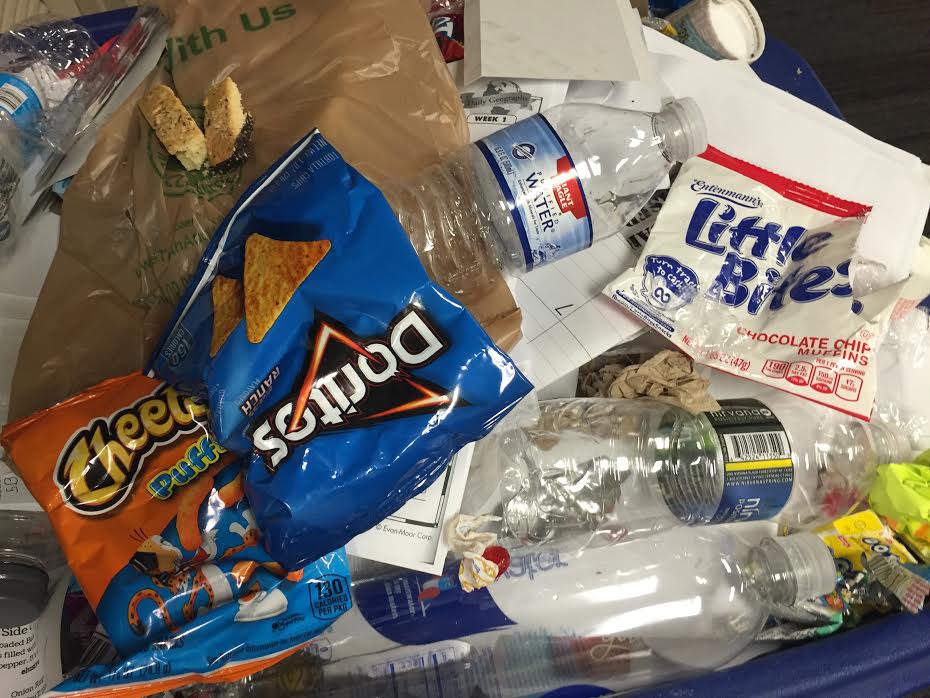Reduce. Reuse. Recycle.
Sounds simple, doesn’t it? The three R’s that we all learned as kids, reminding us that with a little extra effort, we could make our planet a little cleaner. Yet it appears that our community has been struggling with one R in particular: recycling.
Again, it sounds simple. What’s so difficult about putting pieces of paper in the recycling bin or tossing an empty bottle into one of those orange buckets? Evidently, a whole lot. Junior Angel Watkins, one of the recycling leaders in Service Board, said “People are putting trash and non-recyclable materials into the recycling bins . . . there is not an effective way of recycling all materials that need to be recycled because of the trash being put in the bins.”
And that is where the main problem lies. People aren’t taking the time to distinguish between trash and recyclables. A multitude of problems have arisen, many of which we don’t seem to consider before throwing a sandwich or candy wrapper into a clearly labelled container.
First, let’s start with what happens to tarnished recyclables. When someone throws a half-empty Starbucks drink into the paper recycling bin, the bin’s contents become contaminated. Students typically dump the bins without sorting through stacks of potentially dirtied paper, so everything gets taken to the recycling plant. At that point, we may think our job has been done: the bins have been dumped, and now the plant can do its job. Not true. Watkins said, “. . . if they see things in there that are contaminated, they cannot use that whole bin. They can’t recycle it.”
While the recycling plant does sort everything that comes through, receiving contaminated items only hinders the process. “After a while, if [the contents] are so contaminated, it damages their machinery, makes the process longer, and cuts down on their ability to recycle effectively,” said Mrs. Bening. Although it seems that we’re making a difference by recycling, our increasing neglect leads to diminishing benefits for the environment.
Next, there are the immediate effects to the recycling system within our school. As most of us have heard, the Upper School is no longer recycling plastic. Whether you’ve noticed, the bottle-shaped bins that used to line our hallways and the buckets in the teachers’ rooms have been removed. Understandably, this decision has caused some confusion: shouldn’t we be recycling everything we can?
While that sounds ideal, the reality is that it currently can’t be managed. Chip bags, bottles with liquid still in them, silverware, sandwiches, and toast have all been found in both paper and plastic bins. This leads to another problem of hygiene. If people are tossing food items into recycling bins, it’s not long before things start to rot, smell, and attract bugs. “We have made such a mess . . . there has been a breakdown in our system,” said Mrs. Bening. “We need to retrain our community, and we need to start back down at the basic thing, and the thing that we can manage best is paper.” Once a effective paper recycling system is in place, Service Board will explore other methods of recycling bottles, cans, and heavy cardboard.
Finally, there’s the issue of how our recycling predicament reflects our school’s image. Recycling at home on a small scale is much easier than it is at school. Here, everyone has to give a little more effort to ensure both the school and environment stay a little cleaner. That people don’t give a second glance to where they’re tossing their food or can’t take another minute to rinse out a bottle says a lot about our community.
“For most people, [recycling] is not on their priority list,” said Watkins. “Their priority list is, ‘Oh, I need to get to class, don’t have time to think about where I’m putting my trash. I see a bin, I’m going to put it there.’” Whether it’s from a lack of awareness or a lack of care, people have been neglecting their responsibilities, and a new system is needed.
Service Board is taking steps to re-educate and inform the student body. They’ve ordered new bins, and are planning on putting signs that clearly indicate what may be put in them. “It’s just to give them accountability,” said sophomore Caroline Mallory, another recycling leader. “They say, ‘Oh, I didn’t know.’ But you did know.”
What’s more, that students do the recycling is an attempt to give back to the staff that help our school run smoothly. As Watkins said, “We can’t just give back halfway. We have to give back all the way,” but our carelessness just adds to their work.
Think of it as a stream. People at the head are more likely to get clean water, but the people at the end get all of the junk that accumulated during the stream’s flow. We are at the head of that stream, and we have a duty to make the rest of the flow as clean as it can be. “If you start up here and you contaminate it, it just gets worse and worse and worse.” said Mrs. Bening. “Be a part of the solution.”
The sloppiness occurring creates a picture of our community that I know is inaccurate. I know we’re not apathetic towards the environment, and I know we want to show that we care. I know we appreciate the people who allow Academy to run smoothly and want to give back. I know that we’re capable of differentiating between paper and trash. I know that we want to keep our school clean.
And most of all, I know that we can do better.








